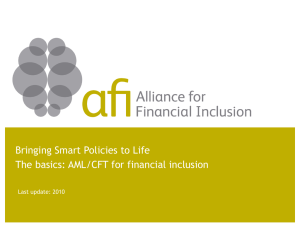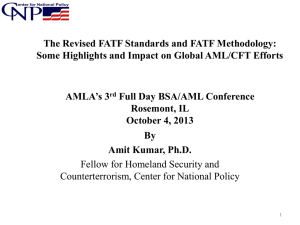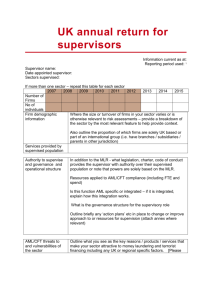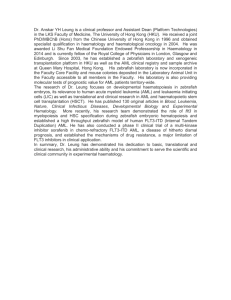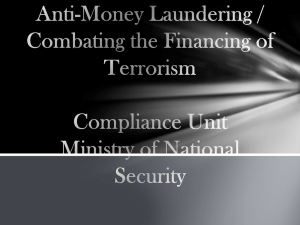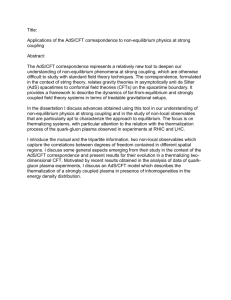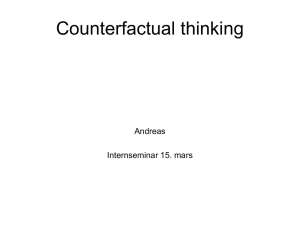(AML/CFT): Risk Assessment Guideline
advertisement
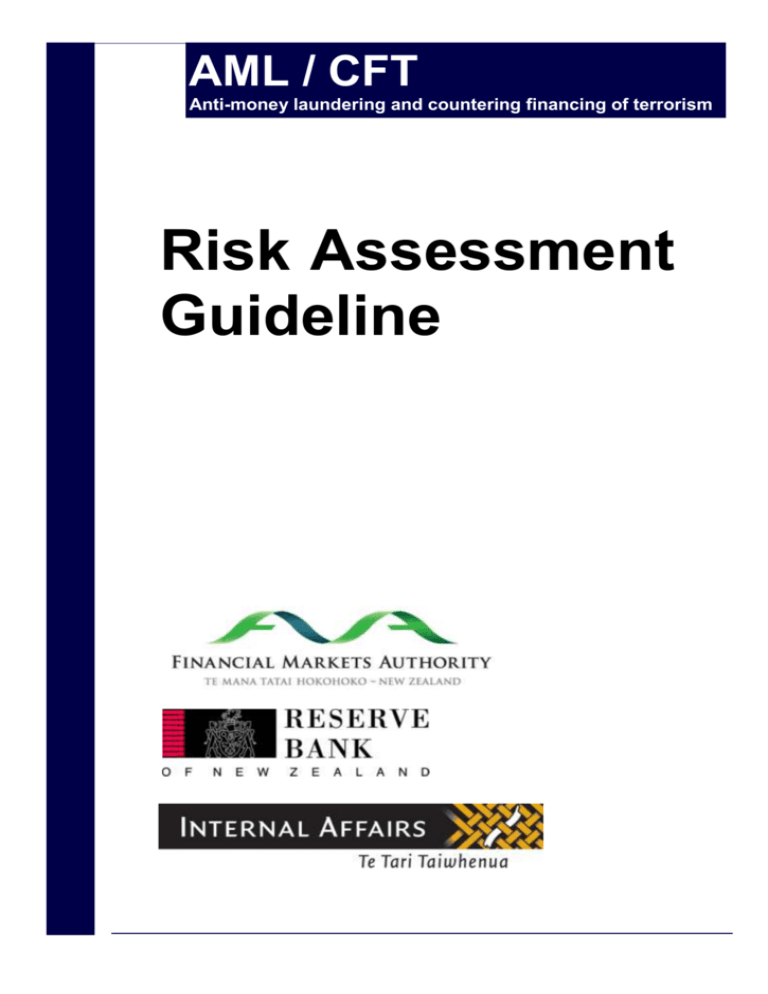
AML / CFT Anti-money laundering and countering financing of terrorism Risk Assessment Guideline About joint supervisory guidelines Each Anti-Money Laundering and Countering Financing of Terrorism (AML/CFT) supervisor is empowered to provide guidance to the reporting entities it supervises by producing guidelines to assist them to comply with the AML/CFT Act and regulations. Each AML/CFT supervisor will also co-operate with its domestic counterparts to ensure the consistent, effective and efficient implementation of the AML/CFT Act. The three AML/CFT supervisors consider that certain high-level principles (which each supervisor will provide) will apply equally to all reporting entities. In such cases, joint guidelines will be issued. Each AML/CFT supervisor may also issue guidelines for specific reporting entities where desirable. Reporting entities should consider all joint and specific guidelines that apply to them. What is this guideline for? 1. This guideline is designed to help reporting entities conduct a risk assessment, as required under section 58 of the Anti-Money Laundering and Countering Financing of Terrorism Act 20091 (AML/CFT Act). 2. A risk assessment is the first step a business must take before developing an antimoney laundering and countering the financing of terrorism programme. It involves identifying and assessing the risks the business reasonably expects to face from money laundering and financing of terrorism. Once a risk assessment is completed, a business can then put in place a programme that minimises or mitigates these risks. Further guidance will be provided on the AML/CFT programme at a later date. 3. Following this guideline is not mandatory. Reporting entities may choose to comply with the AML/CFT Act using alternative methodologies. Background 4. Organised crime and terrorism are global problems, with serious social, economic and political impacts for every country in the world, including New Zealand. 5. Money laundering (ML) allows criminals to disguise the origins of their illicit funds and then use these funds without raising suspicion. 6. Generally ML is a three step process involving: introducing illegally obtained money into the financial system (this step is called “placement”); 1 http://www.legislation.govt.nz/act/public/2009/0035/latest/DLM2140720.html?search=ts_act_antimoney_resel&p=1&sr=1 2 disguising the audit trail so it is difficult to identify the original source of the funds. This is often achieved by breaking funds up and moving them around in a series of complex transactions (this step is called “layering”); transferring the now apparently legitimate funds into a form which they can be used (this step is called “integration”). For more detailed information on ML/FT refer to this website2. 7. The financing of terrorism (FT) involves similar techniques to ML, to avoid detection by authorities and to protect the identity of those providing and receiving the funds. 8. Measures that deter and/or detect ML/FT are an effective way to mitigate the harm to society from crime and terrorism. 9. The AML/CFT Act was passed into New Zealand law on 16 October 2009. The purposes of the Act are to: a) detect and deter ML/FT; and b) maintain and enhance New Zealand’s international reputation by adopting, where appropriate in the New Zealand context, recommendations issued by the Financial Action Task Force3 (FATF); and c) contribute to public confidence in the financial system. Legal obligations relating to risk assessments 10. A business has obligations under the AML/CFT Act if it is a "reporting entity" under the AML/CFT Act. A business is a reporting entity if, in the ordinary course of business, it conducts one or more from a list of 13 financial activities set out under section 5 of AML/CFT Act or it is a casino or a person or class of persons declared by regulations to be a reporting entity. To work out if your business is a reporting entity under the AML/CFT Act, refer to section 5 of the AML/CFT Act 11. Section 58 of the AML/CFT Act requires each reporting entity to assess the risk of ML/FT it may reasonably expect to face in the course of its business. The AML/CFT Act calls this a risk assessment. 12. Under section 58, a reporting entity must set out its risk assessment in writing, and include a description of how this risk assessment will be kept up to date. Risk assessments must enable reporting entities to determine the level of risk involved in relation to relevant obligations under the AML/CFT Act (such as conducting customer due diligence). 13. Reporting entities must use their risk assessment to develop their AML/CFT programmes as set out in section 57 of the AML/CFT Act. 14. Reporting entities must review and audit their risk assessment as set out in section 59 of the AML/CFT Act. Risk assessments must be independently audited 2 http://www.fatfgafi.org/document/29/0,3343,en_32250379_32235720_33659613_1_1_1_1,00.html#Whatismoneylaun dering 3 http://www.fatf-gafi.org/pages/0,3417,en_32250379_32235720_1_1_1_1_1,00.html 3 by an appropriately qualified person every two years, or at any other time at the request of a reporting entity’s AML/CFT supervisor. Under section 60 reporting entities must prepare an annual report on their risk assessment for their supervisor. 15. It is not mandatory to adopt the process this guideline sets out for preparing a risk assessment. As long as a reporting entity complies with its obligations under the AML/CFT Act and any other applicable laws or regulations, it can choose the method of risk assessment that best suits its business. For example, large financial institutions are likely to have their own systems and methodology for conducting a risk assessment. What you will find in this guideline 16. You understand your business better than anyone else. Therefore, you are best placed to identify the risks your business faces from ML/FT, to assess the likelihood of ML/FT occurring through your business and to develop appropriate strategies to manage and control these risks. 17. This guide is designed to help your business comply with its obligations under section 58 of the AML/CFT Act by explaining how you could assess the risk of ML/FT that your business could reasonably be expected to face. 18. This guideline is in four parts: i. ii. iii. iv. Assessing the risk Applying a risk assessment Review and audit of a risk assessment Additional resources to help conduct a risk assessment Assessing the risk 19. Assessing the risk involves: i. Identifying aspects of your business that may be susceptible to ML/FT; then ii. considering each of the at-risk areas you have identified, analysing the likelihood that your business will be used for ML/FT. Identifying aspects of your business that may be susceptible to ML/FT 20. When a reporting entity is identifying aspects of its business that make it susceptible to ML/FT, section 58 of the AML/CFT Act requires the reporting entity to consider all of the following: the nature, size and complexity of its business; the products and services it offers; the way it delivers its products and services; the types of customers it deals with; the countries it deals with; and the institutions it deals with. 4 21. Reporting entities are also legally obliged to consider any applicable guidance material produced by their AML/CFT supervisor or the Commissioner of Police relating to risk assessments and any other factors that may be provided for in regulations.4 22. We recommend a comprehensive and well-structured approach to assessing the extent to which each of the above factors would make your business susceptible to ML/FT. 23. Below is a more detailed explanation of the factors set out in section 58. Overall, we recommend that reporting entities carefully consider any aspect of their business that makes it easier for customers to disguise their identity or the origin of their funds. The nature, size and complexity of your business 24. The size and complexity of a business plays an important role in how attractive or susceptible it is for ML/FT. 25. For example, because a large business is less likely to know its customers personally, it could offer a greater degree of anonymity than a small business. Likewise, a business that conducts complex transactions across international jurisdictions could offer greater opportunities to money launderers than a purely domestic business. The products and services your business offers 26. Some products and services are attractive for ML/FT. When considering whether the products and services your business offers could be susceptible or attractive for ML/FT, we recommend you consider issues such as: Does the product allow payments to third parties? Using third parties to mask the illegal origins of the funds is a known method of ML/FT. Does the product commonly involve receipt or payment in cash? FATF’s 2010 Threat Assessment5 indicates that a significant proportion of ML/FT involves cash. Does the product allow customer anonymity? In order to evade detection by law enforcement authorities, criminals will seek out products that permit their identity to remain unknown. Does your business offer any products or services that have been identified in National or Sector Risk Assessments as higher risk? Does your business only offer low-risk superannuation products? 27. FATF, the Asia Pacific Group on Money Laundering (APG), and the New Zealand Police Financial Intelligence Unit (FIU) publish a list of methods and trends that have been known to be used for ML/FT. We recommend that you read this list closely to stay up-to-date with ML/FT methods6. 4There is nothing specific in Regulations at this time. Future regulations could specify factors that you must consider when you assess your ML/FT risk 5 http://www.fatf-gafi.org/dataoecd/48/10/45724350.pdf 6 http://www.apgml.org/frameworks/ 5 The way your business delivers its products and services 28. The way your business delivers its products and services affects its susceptibility or attractiveness for ML/FT. For example: Does your business have non-face-to-face customers (via post, telephone, internet, etc)? Internet based securities trading accounts, for example, pose particular challenges for verifying the identity of the account holder. Does your business have indirect relationships with customers (via intermediaries, pooled accounts, etc)? The types of customers your business deals with 29. Some categories of customers pose a higher risk of ML/FT including: customers involved in occasional or one-off transactions above a certain threshold; customers who use complex business structures that offer no apparent financial benefits; customers who are Politically Exposed Persons (PEPs). Please refer to the definition in section 5 of the AML/CFT Act to understand the types of individuals who are considered to be PEPs; customers involved in cash-intensive businesses, who may be used by criminals to mask illegally obtained funds; customers involved in businesses with high levels of corruption (e.g. arms dealing); customers whose origin of wealth and/or source of funds cannot be easily verified or where the audit trail appears to be broken and/or unnecessarily layered; customers who conduct business through or are introduced by "gatekeepers" such as accountants, lawyers, or other professionals; customers who are non-profit organisations; and customers of a type that have been identified in National or Sector Risk Assessments as higher risk. 30. Categories of customers whose features may indicate a lower risk include: customers who are employed and receive a regular source of income from a known source (e.g. salaried persons, pensioners, benefit recipients); and customers with a long-term and active business relationship with the firm. The countries your business deals with 31. There is no universally agreed definition for a high risk country, but consider: countries subject to United Nations sanctions7 embargoes or similar measures; countries identified by credible sources such as the FATF as lacking adequate AML controls;8 7 8 http://www.un.org/sc/committees/index.shtml http://www.fatf-gafi.org/document/31/0,3343,en_32250379_32236992_46237087_1_1_1_1,00.html 6 countries identified by credible sources as supporting FT; countries identified by credible sources as having significant levels of corruption; countries that are tax havens; and countries that are associated with drug production and/or trans-shipment. The institutions your business deals with 32. Does your business deal with other financial institutions which are either unregulated, shell companies or shell banks? Such institutions are more likely to be used for ML/FT or could be operated by criminals for ML/FT. Other factors to consider when identifying aspects of your business that may be susceptible to ML/FT: 33. Section 22 of the AML/CFT Act sets out circumstances where every reporting entity must conduct enhanced customer due diligence. Section 18 of the AML/CFT Act provides circumstances where simplified customer due diligence applies. These two sections of the AML/CFT Act are a useful reference point for the types of situations which may be considered to present a high or low risk of ML/FT. 34. Sections 26 to 30 of the AML/CFT Act set out special steps reporting entities must take in relation to PEPs, wire transfers, correspondent banking and new technologies. This information should assist you when identifying high risk areas of your business. 35. The National Risk Assessment9 published by the FIU and the Sector Risk Assessment prepared by your AML/CFT supervisor are also useful sources of information when identifying how your business could be used for ML/FT. You should also consider the emerging trends that are signalled by the FIU when identifying risks in your business. 36. Detailed information on current ML/FT methods is available on the FATF website10. This website also has links to other internet pages that you could refer to when assessing the risk your business could be reasonably expected to face. Assessing the likelihood of your business being used for ML/FT 37. In this step the aim is to rate the likelihood that the aspects of your business that you have identified as susceptible to ML/FT could result in ML/FT. 38. This involves considering each aspect you have identified, together with your business experience, information published by regulators and international organisations such as FATF. 39. You should allow for all the different situations which currently arise in your business (or is likely to arise in the foreseeable future, e.g. from proposed new 9 National Risk Assessment Primary Document http://www.justice.govt.nz/policy/criminal-justice/amland-cft/20110308-NRA-2010-Primary-Document-FINAL.pdf National Risk Assessment Support Document http://www.justice.govt.nz/policy/criminal-justice/aml-andcft/20110308-NRA-2010-Support-Document-FINAL.pdf 10 http://www.fatf-gafi.org/pages/0,2987,en_32250379_32235720_1_1_1_1_1,00.html 7 products, services or customer types). For example, a long-standing, well known customer from a high-risk country may pose a lower risk than a new customer from this country. 40. If your business decides to use the methodology suggested above, you could start this assessment with each of the different types of customer that your business has (e.g. individuals, trusts, charities, companies). If your business deals with individuals, the first aspect of your business you could consider is in which countries you offer your services to individuals. Next you could consider the types of products and services you offer individuals. 41. The end result of this step will be a likelihood rating for each of the at-risk areas of your business. For example, you could rate each area as either highly likely, likely, possible or unlikely to be used for ML/FT. These ratings will allow your business to apply the appropriate standard of customer due diligence in your AML/CFT programme. 42. This likelihood rating could correspond to: Very unlikely There is very little chance of ML/FT occurring in this area of your business. Possible There is a small chance of ML/FT occurring in this area of your business (perhaps 1% of such transactions). Likely There is a moderate chance of ML/FT occurring in this area of your business (perhaps 10% of such transactions). Very likely There is a high chance of ML/FT occurring in this area of your business (perhaps 20% of such transactions). 43. Applying this methodology, for example, could mean that if you have identified overseas customers as an higher risk area, then the likelihood of one of these customers using your business for ML/FT will depend on factors such as whether: The customer is from a country that is considered high risk (for example because they have (i) high instances of illegal drug trafficking or (ii) weak/inadequate AML/CFT legislation); The customer is new or existing; The customer is a PEP from a country that is internationally known for high corruption rates amongst government officials/politicians; The products that your business offers this customer could be used to transfer funds or derivatives across borders; and Your business offers this customer the opportunity to conduct transactions through alternative trading platforms through Internet based trading accounts. 44. Carrying on with the example, if your business has existing customers from countries that are known to have high instances of illegal drug trafficking and you offer these customers complex, internet-based financial products (that do not require face-to-face contact), then you would probably rate the likelihood of your business being used for ML/FT by those customers as “very likely”. 45. Your AML/CFT programme (about which we will provide further guidance in due course) should then address this high risk with appropriate control measures. 8 46. Alternatively, if your business only has overseas customers that are expatriate New Zealanders living in England, and the only products offered to them are superannuation packages, then these customers are very unlikely to be able to launder money or finance terror through your business, and therefore pose a low risk. 47. We recommend that when assessing the likelihood of your business being used for ML/FT, your current AML/CFT controls (if any) are not taken into account. This is because your new AML/CFT programme should include current as well as new measures to prevent ML/FT. (If you take your current AML/CFT controls (if any) into account when conducting the risk assessment it may prove difficult to factor them into your new AML/CFT programme.) Applying a risk assessment 48. A reporting entity’s risk assessment must enable it to prepare a comprehensive AML/CFT programme. It must enable the reporting entity to meet its relevant obligations under the AML/CFT Act and AML/CFT Regulations, especially its obligations to conduct customer due diligence and ongoing customer due diligence. Please refer to sections 14, 18, 22 and 31 of the AML/CFT Act. Review and audit of a risk assessment Reviewing a risk assessment 49. Section 58 of the AML/CFT Act requires a reporting entity to describe how its risk assessment will remain current. This could be achieved by a reporting entity stating in its risk assessment how it will stay up-to-date with ML/FT methods, and how it will factor any relevant changes in international ML/FT trends into its risk assessment. 50. Section 59 of the AML/CFT Act requires a reporting entity to review its risk assessment to: ensure it is current; and identify any deficiencies in the effectiveness of the risk assessment; and make any changes to the risk assessment identified as being necessary in this process. Auditing of risk assessments 51. Under section 59(2) of the AML/CFT Act, a reporting entity must ensure that its risk assessment is audited every two years, or at any other time at the request of its AML/CFT supervisor. Who can audit my risk assessment? 52. Section 59 of the AML/CFT also states that the auditor must be appropriately qualified to conduct the audit. This does not necessarily mean that the person has to be a Chartered Accountant or qualified to undertake financial audits. It does mean that the person has relevant skills or experience to conduct the 9 assessment. (For example, people with AML/CFT or relevant financial experience might be suitably qualified.) A reporting entity must be able to justify to its supervisor how its auditor is appropriately qualified. The audit should be conducted by an independent person 53. Section 59 of the AML/CFT further provides that the person who conducts this audit must be independent, and not involved in the development of a reporting entity’s risk assessment, or the establishment, implementation or maintenance of its AML/CFT programme. 54. The person appointed to undertake the audit may be a member of your staff, provided he/she is adequately separated from the area of your business carrying out the activities described in section 59(5). 55. Similarly, a reporting entity may choose to appoint an external firm to undertake both the audit, and the activities described in section 59(5), provided it has first satisfied itself that there are appropriate separation and conflict of interest arrangements in place in that external firm to meet the requirements of 59(5), and that the reporting entity reviews this decision whenever appropriate under 59(2). Additional resources to help you conduct your risk assessment 56. Information available at the sites listed below may assist your business in conducting its risk assessment: NZ Police FIU National Risk Assessment; AML/CFT Supervisors’ Sector Risk Assessments; Financial Action Task Force; The Asia/Pacific Group on Money Laundering (APG); Australian Transaction Reports and Analysis Centre; Joint Money Laundering Reporting Group. 57. The APG has identified 22 known methods of ML/FT. Because ML/FT methods are always evolving, it is possible that you may come across methods that are not on the list below: i. ii. iii. iv. v. vi. vii. viii. ix. x. xi. xii. xiii. Association with corruption Currency exchanges/cash conversion Cash couriers/currency smuggling Structuring (smurfing) Use of credit cards, cheques, promissory notes etc. Purchase of portable valuable commodities Purchase of valuable assets Commodity exchanges (barter) Use of wire transfers Underground banking/alternative remittance services Trade based ML/FT Gaming activities Abuse of non-profit organisations 10 xiv. xv. xvi. xvii. xviii. xix. xx. xxi. xxii. Investment in capital markets Mingling (business investment) Use of shell companies/corporations Use of offshore banks/businesses Use of nominees, trusts, family members or third parties etc. Use of foreign bank accounts Identify fraud/false identification Use of "gatekeeper" professional services New payment technologies. 11


